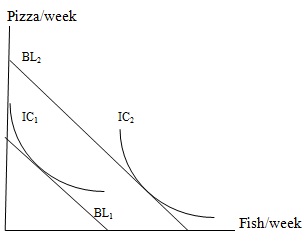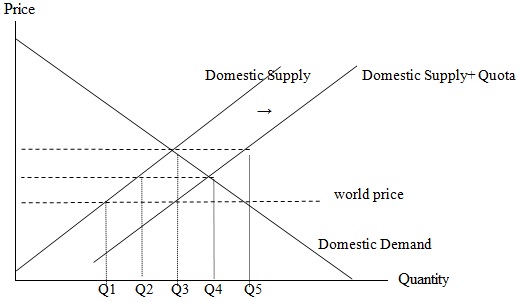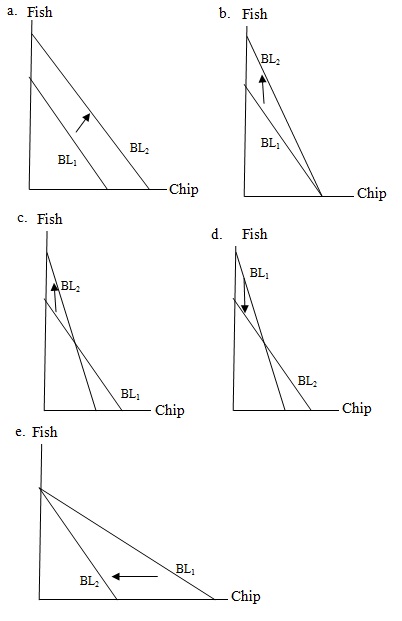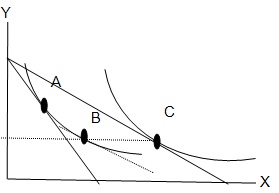BINARY CHOICE QUESTIONS:
Problem 1) If marginal cost is increasing for some firm as the level of it output increases, then its average total cost is increasing.
a. True
b. False
Problem 2) Perfect competition means
a. The demand curve that any individual firm faces is perfectly elastic and the market demand is also perfectly elastic.
b. Firms get the same profit whether they produce at the point where marginal revenue equals marginal cost or at the point where price equals marginal cost.
Problem 3) In the short run, fixed costs don’t affect a firm’s decision about whether or not it should continue to produce in the market.
a. True
b. False
Problem 4) What can we learn about pizza from the following picture?
a. Pizza is a normal good
b. Pizza is an inferior good

Problem 5) Suppose that one kilogram (kg) of seed applied to a plot of land produces one metric ton of harvestable crop. You might expect that an additional kg of seed would produce an additional metric ton of output. However, if __________, that additional kg will produce less than one additional metric ton of harvestable crop (on the same land, during the same growing season, and with nothing else but the amount of seeds planted changing).
a. there are diminishing marginal returns
b. there are decreasing returns to scale
Problem 6) Think of a market for any consumption good where demand is relatively more elastic than supply (the absolute value of the slope of the demand curve is lower than the absolute value of the slope of the supply curve). Then if a tax is placed on the good in this market,
a. tax incidence will be relatively higher on producers.
b. tax incidence will be relatively higher on consumers.
Problem 7) “Tariffs cause deadweight loss because they move the price of an imported product closer to the equilibrium price without trade, thus reducing the gains from trade”. Is this statement completely true?
a. Yes.
b. No.
Problem 8) The price of fish in 1999 is $8 per unit and the price of fish in 2004 is $12 per unit. The CPI index in 2004, with 1999 as a base year is 1.2. Which of the following statements is true?
a. The real price of fish increased by $4.
b. The real price of fish increased by $2.
Problem 9) A monopolist is a price taker.
a. True
b. False
Problem 10) A demand curve with slope of zero is
a. perfectly elastic.
b. perfectly inelastic.
MULTIPLE CHOICE QUESTIONS:
Problem 11) Luxemburg is a small country in Europe. Before free-trade between Luxemburg and the international market is allowed, the local price of a pound of beef is $4.50 in Luxemburg and $3.50 in the international market.
When free-trade is allowed between Luxemburg and the international beef producers, two things will happen:
a. Luxemburg will import beef and the price of beef in the international market will increase.
b. Luxemburg will export beef and the price of beef in the international market will decrease.
c. Luxemburg will import beef and the price of beef in the international market will decrease.
d. Luxemburg will export beef and the price of beef in the international market will increase.
e. Luxemburg will import beef and the price of beef in the international market will remain constant.
Problem 12) Economists say that the supply and demand for housing are more elastic in the long run than in the short run. Then, when effective rent controls are imposed by a government,
a. the housing shortage is greater in the short run.
b. there is no difference between the shortage in the short run and long run.
c. the housing shortage is greater in the long run.
d. investors will more likely engage in constructing more housing.
e. it is unclear if there is going to be a housing shortage.
Problem 13) The market demand in the organic cherry market is given by P = 80-QD , and the market supply is given by P=QS /3. The government decides to adopt an agricultural policy that will guarantee the price of organic cherries as $23 per pound to the farmers. What level of subsidy should the government set to achieve its price guarantee program?
a. $3 per pound.
b. $9 per pound.
c. $11 per pound.
d. $12 per pound.
e. $20 per pound.
Problem 14) The discovery of a new technique for growing wheat leads to an increase in the supply of wheat. Wheat farmers will realize an increase in total revenue if
a. the supply of wheat is elastic.
b. the supply of wheat is inelastic.
c. the demand for wheat is inelastic.
d. the demand for wheat is elastic.
e. the weather is very favorable for wheat production this season.
Problem 15) Please refer to the following graph. Assume initially there is free trade. With free trade imports are substantial and therefore the domestic government imposes an import quota. What is the quantity that is imported after the imposition of the quota?

a. Q3-Q2
b. Q4-Q3
c. Q4-Q1
d. Q5-Q1
e. Q5-Q3
Problem 16) A profit maximizing monopolist has cost function TC = 10+2Q. Demand in this market is given by the equation Q = 14-P. Calculate the firm’s profit.
a. $16
b. $22
c. $24
d. $26
e. $48
Problem 17) As a firm’s production increases, which of the following occurs?
a. Average Variable Cost always gets closer to Average Total Cost if there is a fixed cost to begin with.
b. Average Total Cost always declines.
c. Marginal Cost generally increases due to diminishing marginal returns of inputs used in production.
d. Both (a) and (b).
e. Both (a) and (c).
18) Consider a consumer with an income of $50. He consumes books and food. The price of books is $10 and the price of food is $5. The indifference curve map is drawn with books on the vertical axis and food on the horizontal axis. What is the slope of the indifference curve at the bundle that maximizes this individual’s utility?
a. -5
b. -10
c. -0.5
d. -2
e. -0.2
Please use the following information for the next 3 questions.
The market for microwave ovens is perfectly competitive. The market demand for microwave ovens is given by QD =110-2P. Assume that the microwave industry is a constant cost industry. The total cost function of an individual firm in the microwave oven market is given by the equation TC=36+10Q+Q2, and the marginal cost function for the firm is given by the equation MC=10+2Q.
Problem 19) In the short run the market equilibrium price is equal to $12. A profit maximizing firm produces ____unit(s), its profit is _____ and there are ____ firms in the market.
a. 1, $35, 86
b. 1, -$35, 86
c. 11, -$35, 84
d. 2, -$36, 43
e. 2, $36, 43
Problem 20) What is the long run equilibrium price and how many firms are there in this market in the long run?
a. $22, 86 firms
b. $22, 11 firms
c. $10, 11 firms
d. $10, 6 firms
e. $22, 60 firms
Problem 21) Consider the microwave market in its long run equilibrium. Now assume that the market demand changes due a change in the number of consumers in the population. The new market demand is characterized by the equation QD =140-2P. Which of the following is true?
a. There are more firms in the market in the new long run equilibrium.
b. Each firm in the market produces more in the new long run equilibrium.
c. The total quantity produced in the market is less in the new long run equilibrium.
d. Some firms will shut down in the short run.
e. The market price is higher in the new long run equilibrium.
Problem 22) Suppose that a consumer has an income of $1200 and that he spends his income on fish and/or chips. Furthermore, suppose initially that the price of fish is $10 per unit while the price of chips is $5 per unit. The government decides to tax fish with an excise tax that increases the price of fish by 20%. Call the budget line with this tax BL1. Now, suppose that the government decides to cancel the tax on fish (the price of fish returns to its original level, $10), and instead levy a tax of 10% on income. Call the budget line with the income tax BL2. Which of the following diagrams accurately depicts BL1 and BL2?

Problem 23: Usiung the picture below, which of the following statements is true?

a. Both goods are normal goods.
b. Only Y is a normal good.
c. The income effect moves the best affordable consumption bundle from A to B.
d. The substitution effect moves the best affordable consumption bundle from A to B.
e. The income effect makes the consumer consume more Y.
Problem 24) As a result of using the marginal cost pricing rule to regulate a natural monopoly,
a. the natural monopoly will incur an economic loss.
b. the natural monopoly earns a normal profit.
c. the monopolist produces an inefficient amount of product.
d. the monopolist is allowed to cover all its costs and earn a normal profit.
e. it yields a smaller consumer surplus than does the average cost pricing rule.
The following table pertains to the next 3 questions
Quantity Fixed Cost Marginal Cost Total Cost
0 20 0 20
1 20 5 25
3 20 6 36
4 20 8 44
Problem 25) Assume that Acme is a perfectly competitive firm. The cost schedule given above is for the Acme firm, which produces widgets. The price of widgets is currently $6. What is the profit maximizing number of widgets for Acme in the short run?
a. none
b. 0
c. 1
d. 3
e. 4
Problem 26) If Acme produces 4 widgets, what will its average variable cost be?
a. $12 per unit
b. $11 per unit
c. $5.33 per unit
d. $6 per unit
e. $8 per unit
Problem 27) What is the optimal production decision for this firm?
a. Continue producing in the short run, but discontinue production in the long run.
b. Discontinue production immediately.
c. Continue producing in the short run and long run.
d. Charge a higher price than the market price in order to avoid losses.
e. None of the above.
Problem 28) A firm doubles all of its inputs and finds that it triples the amount of output it produces. Then this firm
a. Is experiencing decreasing returns to scale over this region of production.
b. Is experiencing diminishing returns to scale over this region of production.
c. Has an upward sloping Long Run Average Total Cost Curve (LRATC) over this region of production.
d. Has a downward sloping Long Run Average Total Cost Curve (LRATC) over this region of production.
e. None of the above.
Problem 29) Assume that you have a market where the demand for the product is linear and equal to P=100-4Q. Furthermore assume that there is only one firm that produces the good, and that this firm’s marginal cost is constant and equal to $4, no matter how many units are produced. What price will the monopoly set in this market if it maximizes its profits?
a. $48
b. $50
c. $52
d. $54
e. $56
Problem 30) Suppose there is a perfectly competitive industry in long run equilibrium. The industry is a constant cost industry. Furthermore suppose the price of a substitute good in consumption increases. Holding everything else constant, a representative firm in this industry will find that
a. Short run equilibrium price increases, it makes positive economic profit in the short run, and the firm’s long run equilibrium output increases.
b. Short run equilibrium price does not change, it makes positive economic profit in the short run, and the firm’s long run equilibrium output increases.
c. Short run equilibrium price increases, its profit in the short run stays the same, and the firm’s long run equilibrium output stays the same.
d. Short run equilibrium price increases, it makes positive economic profit in the short run, and the firm’s long run equilibrium output does not change.
e. Short run equilibrium price increases, it makes positive economic profit in the short run, and the firm’s long run equilibrium output decreases.